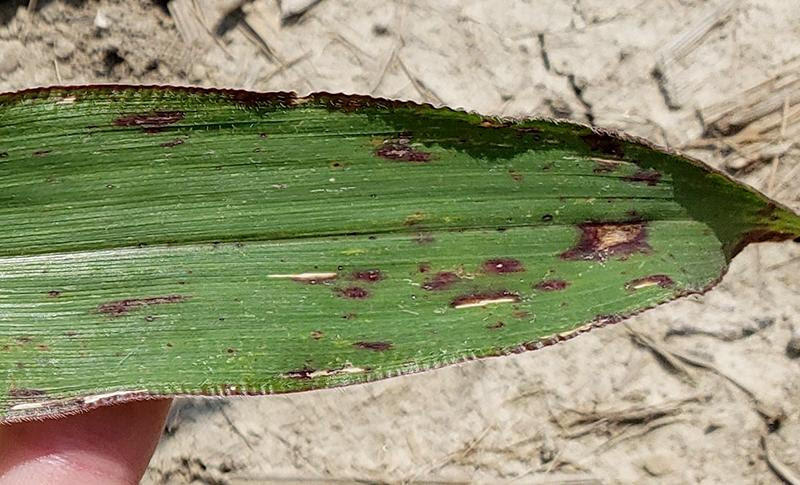 |
|
News Bits
By Todd Janzen, Janzen Ag Law Blog
I was fortunate to be asked to testify before the U.S. Senate Agricultural Committee recently about the impact of artificial intelligence (AI) on agriculture. Although AI and its simpler cousin machine learning (ML) have operated behind the scenes for years already, 2023 is the first time that AI and ML really entered the public discourse. It is clear to me that agriculture, like other industries, needs time to digest what AI means for the future. This post explores how to apply AI's often discussed legal issues to agriculture.
Bias. AI "bias" refers to the implicit biases in the values that determine which datasets are used to train applications. There are many ways bias might negatively impact ag tools, from selection of seed varieties, to breeding genetics, to fertilizer and pesticide application. A danger here is that diversity of choice is lost as AI tools favor certain products over others based upon biases that are unknown to the users.
License of Training Data. AI and ML require vast amounts of training data to make decisions that valuable and "correct". Some data is publicly available, but most will need to come from farmers. For technology providers, the important AI consideration is to make sure that training data is properly licensed from farmers. Otherwise, the AI predictions may be based upon unlicensed data and thing brings a host of problems surrounding ownership of the AI models.
Privacy of Data. We know farmers are concerned the privacy of their ag data. Most user agreements establish privacy protections for farmers for this purpose. AI tools should not be able to blow through these privacy walls. In other words, if a person working for a technology company cannot lawfully access a farmer's data, the AI tool at the same company should not have greater access (unless such access is licensed).
Ownership of Intellectual Property Works. AI has upset the traditional legal understanding of what it means to own a creative work, such as a movie, book, or article, which are protected from plagiarism by copyright laws. Can a computer generate a new, creative work? Or is any computer generated work simply derivative of existing works? The same issues might arise from AI tools used in agriculture--is the AI recommendation a protected company secret if generated by open source AI tools?
Antitrust and Anticompetitive Behaviors. Ag tech startups in the last ten years have largely reversed agriculture's consolidation trend from previous 100 years. But we should not assume this will always be the case. For the decades prior to the 2010s, there were fewer and fewer choices for farmers as one merger after another consolidated equipment OEMs, cooperatives, and ag retailers. With great size comes great power. Let's hope that AI does not just benefit the big players, lead to more consolidation and fewer choices, but instead allows smaller ag tech start-ups to compete.
2023 was the year of AI. I'm sure that 2024 will see even more AI tools arrive on the farm. What issues do you think congress should consider as this discussion advances?
To read my testimony before the Senate Ag Committee, click here: Innovation in American Agriculture: Leveraging Technology and Artificial Intelligence
National Association of Farm Broadcasting (NAFB) reports:
Senators Chuck Grassley, Joni Ernst and Tammy Baldwin are leading a bipartisan push to shed light on market factors driving the cost of fertilizer. Iowa Republicans Grassley and Ernst, along with Wisconsin Democrat Baldwin, have introduced the Fertilizer Research Act.
The legislation would require the Department of Agriculture to study competition and trends in the fertilizer market to determine their subsequent impacts on price.
Grassley says, "With fertilizer being one of the ag industry's highest input costs, it's problematic farmers have such a limited window into market fluctuations."
Within one year of the bill's passage, the Secretary of Agriculture, in consultation with the Economic Research Council, would be required to issue a report on USDA's website regarding the U.S. fertilizer industry. The report would include a description of impacts on the fertilizer market that influence price, market trends in the past 25 years, and impacts of anti-dumping and countervailing duties, among other research items.
|
|
New research offers insights into the biochemistry that makes grasses flower
University of Wisconsin release:
|
 |
|
Pictured here are two Brachypodium plants. Researchers at UW–Madison have identified a gene known as ID1 that triggers a biological cascade of gene expression, leading to normal flowering. The plant on the left is flowering normally, thanks to the presence of ID1. In the plant on the right, a mutated ID1 gene has led to improper expression of downstream FT1 and FTL genes, resulting in a plant that continues to produce leaves instead of flowers.
Floral timing has major implications for agricultural crops because flowering is a key stage in their reproductive process. Biochemical pathways that lead to flowering have been extensively studied in the model organism Arabidopsis a plant in the mustard family. But little research exists on how these pathways differ in grasses – a distinct, agriculturally important family of plants. Now, new research by biochemists at the University of Wisconsin–Madison reveals a key component in the cascade of genes that regulate a key protein involved in grass’ flowering, offering insights into the onset of flowering in crops such as wheat, rye and barley.
What you need to know
Because they can’t uproot themselves and hunt for food, plants are exceptionally responsive to their environment, acquiring what they need to survive from their immediate surroundings. From sun, soil and rain, for example, plants access nutrients and water. Similarly, plants evolve mechanisms to make the most of their reproductive efforts by taking cues from their environment — flower too early and they risk frost damage; flower too late and the plant may miss the optimal growing season.
In many plants, the biochemical pathways that lead to flowering are triggered by specific daylengths (photoperiods) or exposure to the prolonged cold of winter (vernalization), ensuring that the onset of flowering coincides with appropriate environmental conditions. Some aspects of these pathways are similar across many families of plants. For example, all flowering plants require sufficient levels of a protein known as florigen to transition from the growth stage to the reproductive stage of their life cycle.
Regulation of the florigen family of genes involves a cascade of upstream genes turning on or off, creating a carefully orchestrated pathway that relies on environmental and biochemical cues. Arabidopsis thaliana, a member of the mustard family, has long been the standard model organism for studying plants, including flowering pathways.
But the genes responsible for regulating the onset of flowering differ across plant families. It is only since the early 2000s that plant researchers have worked with a model organism representative of temperate grasses: Brachypodium distachyon. As a result, little is known about the intricacies of florigen regulation in this plant family.
Why it matters
The timing of flowering can be essential to agricultural practices. Yields of important agricultural grasses such as wheat, rye and barley depend heavily on environmental factors such as pollinators, day length and temperature. Efficient harvesting relies on synchronistic timing of flower production across a field.
For these reasons, floral timing is a key trait that scientists consider when breeding crops to optimize yield. Discoveries about the genes that control the timing of flowering can offer key clues to plant breeders aiming to develop crops that are well adapted to a given climate, which, in turn, can benefit farmers’ crop yields.
How our scientists made progress
Researchers in the Amasino Lab in the Department of Biochemistry have identified a gene responsible for regulating florigen genes in temperate grasses. Their findings, recently published in PNAS, reveal new insights into the biochemical pathway responsible for flower production.
A suite of florigen genes known as Flowering Locus T (FT) and FT-like (FTL) genes are common to many temperate grasses. The researchers used Brachypodium to investigate how an upstream gene specific to temperate grasses, Indeterminate1 (ID1), impacts expression of FT and FTL genes.
The presence of ID1 was required for several FT and FTL genes to be expressed, indicating that ID1 is involved in regulating these florigen-producing genes. Among other findings, the researchers demonstrated that mutations to the ID1 gene suppressed FTL gene expression, which would result in delayed flowering even when the plant is exposed to optimal environmental conditions.
These results identify the ID1 gene as a critical piece of the flower production pathway in temperate grasses. The research is a crucial step towards understanding how the genes responsible for flowering in grasses such as Brachypodium differ from the pathways scientists have discovered in Arabidopsis.
Check out more in the Department of Biochemistry’s series Research in Brief: The What, Why, and How of new research exploring the world around us — and inside us.
|
|
Factoids
National Corn Growers Association news release
The National Corn Growers Association (NCGA) is excited to announce the winners of the 2023 National Corn Yield Contest. This group of farmers put up some impressive yields and proved, once again, the ingenuity and resiliency of the U.S. farmer.
In its 59th year, the National Corn Yield Contest saw nearly 7,000 entries from farmers in 46 states. Entrants across the 10 production categories, including the pilot category for nitrogen management, Class J, had verified yields averaging 269 bushels per acre, compared to the projected national average of 173 bushels per acre. This includes a new national record yield of 623.8439 bushels per acre from David Hula in Charles City, VA, besting the previous record of 616.1953 bushels per acre.
"Year after year, the National Corn Yield Contest remains the most popular program for NCGA members," said Harold Wolle, president of the National Corn Growers Association. "It is an opportunity for farmers across the country to put their skills to the test and show the true craftmanship it takes to grow a successful corn crop, and the agronomic data generated by the contest each year helps provide valuable information for future success."
The 27 national, 526 state and 3 Class J winners will be honored by NCGA at Commodity Classic in Houston, TX, February 28 - March 2, 2024.
A complete list of the 2023 National and State winners can be found at ncga.com/ncyc.
|
|
FIRST CRISPR GENE-EDITED DRUG APPROVED BY FDA
by Joseph Walker, Wall Street Journal
The gene-editing revolution is jumping from the lab to the marketplace.
The U.S. has approved the world's first medicine employing Crispr technology, a Nobel Prize-winning discovery that promised a powerful new tool for modifying genes to treat disease and improve crop production.
The new treatment, called Casgevy and developed by Vertex Pharmaceuticals and CRISPR Therapeutics, was cleared Friday for treatment of people with the painful sickle-cell disease.
The landmark decision by the Food and Drug Administration heralds a powerful new kind of medicine, one that turns off or replaces genes to tackle conditions that have long confounded doctors and researchers.
Several companies are developing Crispr-based therapies for diseases including heart disease, cancer and rare genetic disorders. Next-generation gene-editing techniques promise to make it easier to administer the therapies with fewer side effects.
How Casgevy works for sickle-cell patients
Sickle-cell disease is caused by an inherited genetic mutation that results in a dysfunctional form of the protein, called hemoglobin, that carries oxygen in the blood.
Casgevy goes after a different gene that, when switched off, allows for the production of a form of hemoglobin that is produced when babies are in the womb that provides a functional substitute for the malformed adult hemoglobin caused by sickle-cell disease.
The therapy's approval "shows the promise of genetic therapies that seek to treat disease at the source by making a targeted change in a person's DNA," said Jennifer Doudna, who shared a Nobel Prize in 2020 for her work helping discover Crispr. "It almost changes the way we define a medicine."
Casgevy is a first step in bringing Crispr-based treatments to patients. Unlike Crispr drugs in development, it gene-edits a patient's cells in a lab, rather than inside a patient's body.
To read the entire article click here.
|
World Agricultural Output and Productivity Growth Have Slowed
International Agricultural Productivity
by Keith Fuglie, Stephen Morgan, and Jeremy Jelliffe
Agriculture draws on significant land and water resources as well as manufactured goods to produce food and industrial raw materials for textiles and biofuel to meet the needs of a growing world population. Increasing agricultural productivity helps meet these demands using existing resources. The USDA, Economic Research Service data product on International Agricultural Productivity tracks the total volume of global agricultural output (the amounts of crop, animal, and aquaculture commodities produced at constant prices) and the total amounts of land, labor, capital, and materials (inputs) used to produce this output for the world as a whole and for individual countries. Over the last six decades (1961 to 2021), world agricultural output increased at an average annual rate of 2.3 percent, faster than the 1.2-percent average growth rate for input use. This means world agricultural total factor productivity (TFP)— the ratio of total output to total input—grew 1.1 percent a year. In other words, improvement in total productivity was responsible for nearly half the growth in world agricultural production.
The accompanying chart shows the average rate of world agricultural growth by decade since the 1960s and breaks down the sources of that growth into the shares from four changes:
- bringing more land into production (without changing yields),
- extending irrigation to land,
- raising yields by intensifying the use of capital, labor, and material inputs per unit of land, and
- improving total factor productivity.
-
In the 1960s and 1970s, the additional use of resources such as fertilizers—known as input intensification—to increase yields was the main driver of world agricultural growth. Since the 1990s, growth in agricultural TFP has been the major source of output growth. Agricultural TFP increases when farmers adopt new technologies and practices that help them use their resources more efficiently. In addition, long-term investments in research and development (R&D) are key to determining how well agricultural TFP growth can be sustained.
From 2011 to 2021, world agricultural output grew at an average annual rate of 1.94 percent, far slower than the 2.74-percent growth of the previous decade (2001–2010). The slowdown primarily was tied to a slowing rate of growth in agricultural TFP, which declined to 1.14 percent a year in 2011–21 from 1.93 percent a year the previous decade. The effects of slower productivity have been widespread around the world.
Several factors may have contributed to the slowing growth rate for world agricultural productivity. Climate change is increasing the frequency of extreme weather events, which could lead to a reduction in average yields. Public and private investments in agricultural R&D may not be keeping pace with the need for new technologies, including technologies to address challenges from changing climate conditions, pests, and diseases. Lack of access to, or restrictions on, the use of some new technologies, barriers to trade, and global conflict and war also have had detrimental effects on agricultural production and productivity.
|
|
 Insignum AgTech develops plant genetic traits that enable plants to ‘talk’ and signal to farmers when specific plant stresses begin
Insignum AgTech develops plant genetic traits that enable plants to ‘talk’ and signal to farmers when specific plant stresses begin












